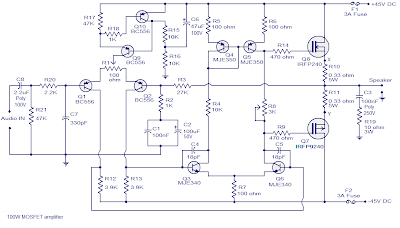 A 100W MOSFET power amplifier circuit based on IRFP240 and IRFP9240 MOSFETs is shown here. The amplifier operates from a +45/-45 V DC twin supply and might deliver 100 watt rms into an 8t ohm speaker and 160 watt rms into a 4 ohm speaker. This Hi-Fi amplifier circuit is appropriate for lots applications like general purpose amplifier, guitar amplifier, keyboard amplifier. The amplifier and also used as a sub woofer amplifier however a subwoofer filter stage should be added before the input stage. The amplifier has a low distortion of 0.1%, a damping issue bigger than 200, input sensitivity of 1.2V and also the bandwidth is from 4Hz to 4 KHz.
A 100W MOSFET power amplifier circuit based on IRFP240 and IRFP9240 MOSFETs is shown here. The amplifier operates from a +45/-45 V DC twin supply and might deliver 100 watt rms into an 8t ohm speaker and 160 watt rms into a 4 ohm speaker. This Hi-Fi amplifier circuit is appropriate for lots applications like general purpose amplifier, guitar amplifier, keyboard amplifier. The amplifier and also used as a sub woofer amplifier however a subwoofer filter stage should be added before the input stage. The amplifier has a low distortion of 0.1%, a damping issue bigger than 200, input sensitivity of 1.2V and also the bandwidth is from 4Hz to 4 KHz.
Capacitor C8 is the input DC decoupling capacitor that blocks DC voltage if any from the input source. IF unblocked, this DC voltage can alter the bias setting s of the succeeding stages. Resistor R20 limits the input current to Q1 C7 bypasses any high frequency noise from the input. Transistor Q1 and Q2 forms the input differential combine and the constant current source circuit designed around Q9 and Q10 sources 1mA. Preset R1 is employed for adjusting the voltage at the output of the amplifier. Resistors R3 and R2 sets the gain of the amplifier. The second differential stage is created by transistors Q3 and Q6 whiles transistors q4 and Q5 forms a current mirror that makes the second differential combine to empty an identical current. this is worn out order to boost linearity and gain. Power amplification stage based on Q7 and Q8 that operates in thee category AB mode. Preset R8 will be used for adjusting the quiescent current of the amplifier. The network comprising of capacitor C3 and resistor R19 improves high frequency stability and prevents the possibility of oscillation. F1 and F2 are safety fuses.
Set R1 at midpoint before powering up and then change it slowly in order to induce a minimum voltage (less than 50mV0 at the output. Next step is fixing the quiescent current and keep the preset R8 in minimum resistance and connect a multimeter across points marked X & Y in the circuit diagram. currently change R8 so that the multimeter reads 16.5mV that corresponds to 50mA quiescent current.
Notes
- Assemble the circuit on a good quality PCB.
- Use a +45/-45 V DC, 3A dual supply for powering the circuit.
- Power supply voltage must not exceed +55/-55 V DC.
- Before connecting the speaker, check the zero signal output voltage of the amplifier and in any case it should not be higher than 50mV. If it is higher than 50mV, check the circuit for any error. Replacing Q1, Q2 with another set could also solve the problem.
- Fit Q7 and Q8 to a 2°C/W heat sink. Both Q7 and Q8 must be isolated from the heat sink using mica sheets. Heat sink mounting kits for almost all power transistors/ MOSFETs of almost all package styles are readily available in the market.
- All resistors other than R10, R11 and R19 are 1/4 watt metal film resistors. R10 and R11 are 5W wire wound type while R19 is a 3W wire wound type.